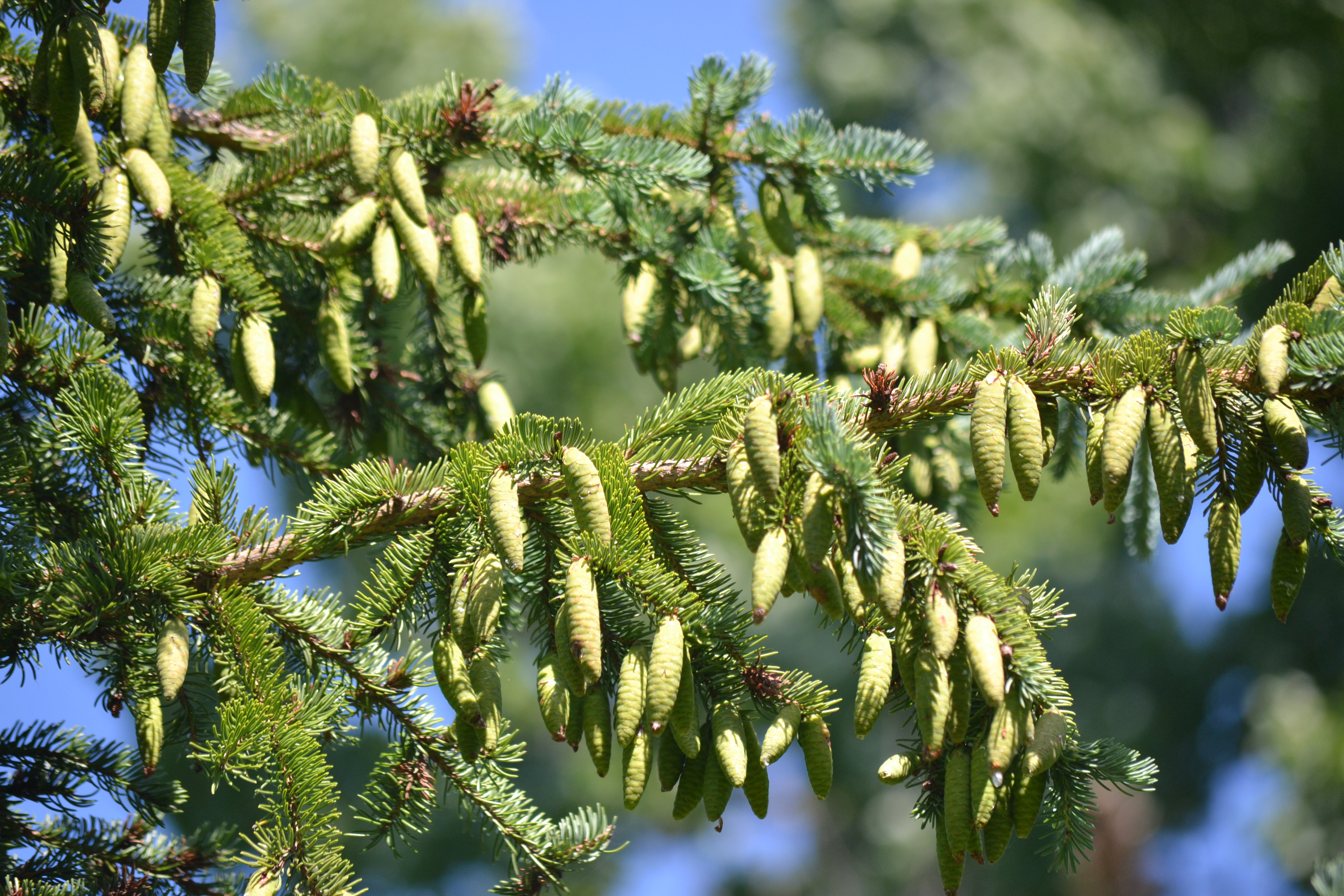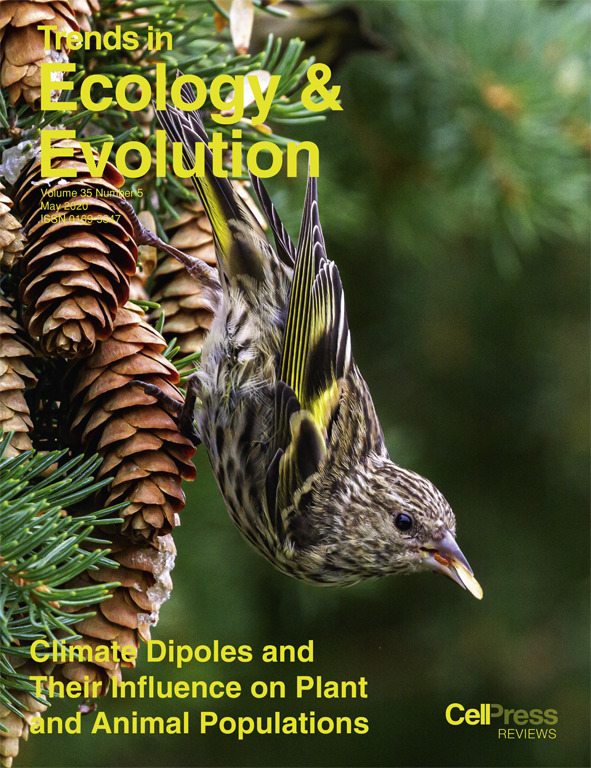 Jalene LaMontagne, an associate professor of ecology at DePaul University, studies mast seeding in white spruce and other boreal conifers. She has co-authored a series of research papers that explore the concept of ecological dipoles on plant and wildlife populations. (Image courtesy of Jalene LaMontagne)
Jalene LaMontagne, an associate professor of ecology at DePaul University, studies mast seeding in white spruce and other boreal conifers. She has co-authored a series of research papers that explore the concept of ecological dipoles on plant and wildlife populations. (Image courtesy of Jalene LaMontagne)
Every summer, ecologist Jalene LaMontagne goes to the Northwoods in Wisconsin, Minnesota, Michigan, and Canada to research white spruce trees. For these trees, like people, some years are more productive than others.
In some years, white spruce trees near each other in forests across North America will produce huge numbers of cones. Other years, they don’t. This synced-up action is called mast seeding. It has a ripple effect through the ecosystem, and is a focus of LaMontagne’s research.
“I am interested in these scales of synchrony — how are individuals the same or different to individuals in a local site, to a broader region, then thinking about the continent,” LaMontagne says.
 Jalene LaMontagne is an associate professor of ecology at DePaul University. (Image courtesy of Jalene LaMontagne)
Jalene LaMontagne is an associate professor of ecology at DePaul University. (Image courtesy of Jalene LaMontagne) LaMontagne, an associate professor in the College of Science and Health, has been having a very productive year so far. She has published research in the journals “
Nature Plants” and “
Trends in Ecology and Evolution” that explore how ecological patterns play out at a continental scale. She also coauthored papers in the “
Journal of Ecology" and "
New Phytologist.” The National Science Foundation is funding her work, part of an effort to enable ecologists and climatologists to better collaborate on research.
Part of this has been working with colleagues to name an emerging field of study: ecological dipoles. This approach recognizes ecological patterns may mirror climatological dipoles like El Niño. In the wake of climate change, it’s more important than ever that ecologists be able to predict how plants and wildlife may be affected, says LaMontagne.
At the outset of her career, LaMontagne studied animal populations, some of which rely on seeds from white spruce trees as a food source. As she learned more about the mast seeding of white spruce, LaMontagne was drawn to the mystery of what drives their reproduction patterns.
"Trees stay in the same spot, so you don’t have to catch them the next year,” LaMontagne says. “They live for a long time, so they’re good to study.”
DePaul students, such as
Cristian Corona, are engaged in hands-on research with LaMontagne’s lab, creating their own projects and securing funding.
“We kind of think we know what’s going on, but then we go into the field, and every year I can be surprised,” LaMontagne says.
Ecological dipoles
In climatology, a dipole describes waves and patterns of weather that create opposite conditions across continents, such as the El Niño and La Niña phases. In a paper published in the journal “Trends in Ecology and Evolution,” LaMontagne and her collaborators note a similar opposite pattern occurs in plants and wildlife separated across continents, but has thus far been widely overlooked.
 Jalene LaMontagne is coauthor of research on ecological dipoles, which is featured on the cover of the April 2020 issue of Trends in Ecology and Evolution. Pictured is the pine siskin feeding on white spruce seeds. Pine siskins irrupt in response to broad-scale changes in food availability and climate variability. (Photo: Bernie Boutin)
Jalene LaMontagne is coauthor of research on ecological dipoles, which is featured on the cover of the April 2020 issue of Trends in Ecology and Evolution. Pictured is the pine siskin feeding on white spruce seeds. Pine siskins irrupt in response to broad-scale changes in food availability and climate variability. (Photo: Bernie Boutin)
“We are drawing attention to this novel approach, which links together a negative pattern and changes of population in animals, plants and other wildlife at a different scale," LaMontagne. says. “Scientists looking at the continental scale for data might see patterns they wouldn’t see if they were only looking across 100 kilometers or 10 kilometers."
While ecologists have long been interested in how local or regional temperature and climate influence organisms, few have looked at continent-wide trends. This approach will help ecologists understand how climate extremes affect ecosystems.
Zooming out to reveal patterns
In her research published in the journal “Nature Plants,” LaMontagne reveals a previously unseen spatial pattern in mast seeding that may help ecologists understand population dynamics at large scales.
While other ecologists have studied relationships between mast seeding and more local weather patterns, LaMontagne and her colleagues looked at continent-wide data. They found at a large geographic scales greater than about 2,000 kilometers, there is a negative or opposite pattern occurring. When white spruce trees in the western half of North America are having a large reproductive year, reproduction tends to be sparse in the East, and vice versa.
“Researchers have observed that if you were at a location, trees close to you are going to be behaving similarly,” she says. “We found that not only does the correlation decline with distance, it gets negative. So trees are doing opposite things on different sides of the continent.”
This is among the largest studies of its kind in mast-seeding research, with 68 datasets compiled from sites covering distances over approximately 5,000 kilometers, or 3,100 miles.
Turning to weather data, LaMontagne discovered she could map the differences in July temperatures from one year to the next and then predict where mast seeding events would occur. The relationship between summer weather and mast seeding was “striking” across the continent.
The researchers used the Daymet daily surface weather and climatological summary dataset, which draws from thousands of weather stations throughout North America. Daymet is supported by NASA and the Department of Energy.
LaMontagne was also invited to write a “behind the paper” post for the “Nature Ecology and Evolution” community explaining the process for her research, which you can read at
https://go.nature.com/2S6L8Sk.